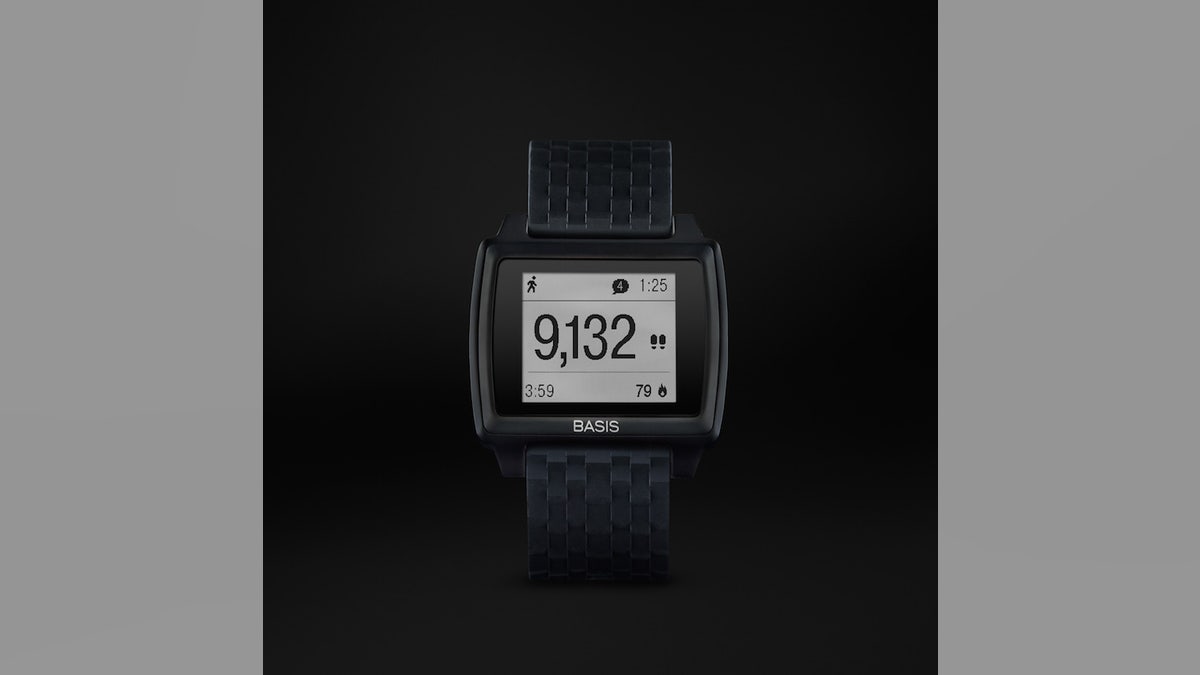
Basis Peak. (Basis)
Are you looking to put something new on a special person's wrist this holiday season? Smartwatches, fitness bands, and activity trackers are expected to be hot items this year, with roughly 19 million already in use, according to Juniper Research. The company expects that within a couple of years, tens of millions more will be sold.
There's a bewildering array of options, from snazzy watches like Martian's Notifier that offer subtle vibrating alerts to rubber wristbands that simply monitor motion and translate it into activities you log in a supplied smartphone app. Most will wirelessly communicate with a smartphone, but some models only work with Apple phones.
Style is also an important consideration since this is a gadget you actually wear. Models vary from neon sports bands to large, geek chic color displays that may be too large for slender wrists. Some people with sensitive skin have found that certain plastic models irritate their wrists, so comfort is a concern. Wearables are also status symbols, so don't buy a bulky $400 everything-but-the-kitchen sink device for a teenager who just wants to track her runs and look good doing it.
Activity Trackers:
Popularized by Fitbit, activity trackers are the least expensive type of wearable technology, usually under $100 and ranging from quarter-sized gadgets that clip onto a pocket to wristbands that can be worn around the clock. Less expensive trackers don't have a display, and most are aimed at people looking to lose weight or start living healthier. They usually employ an accelerometer and often a skin sensor to determine when you're in motion and when you're at rest. Software counts your steps during the day, and supplied programs often include an automated lifestyle coach that helps you set goals, encourages you to reduce caloric intake, and can share your progress with friends on Facebook.
These gadgets can also be stylish or clunky, but the primary consideration should be comfort since many are intended to be worn around the clock to track not only activities but also your sleep patterns. Some models can also be set to vibrate to wake you up in the morning. Remember that the one you choose should fit securely. I lost a Jawbone Up24 while swimming in a lake, and later realized it's only water resistant, not waterproof. You've been warned.
Essential features: Comfort and long battery life.
Best for: The casual user looking to increase their level of activity.
Recommended Model: Fitbit One, $99. It's a clip-on that comes with a wristband. It works with a variety of software, as well as Apple and Android devices, but it's not waterproof.
Fitness Bands:
A step up from basic activity trackers, these rubber and plastic devices are intended to help wearers track running and sports activities. They also work in conjunction with a smartphone app and many are compatible with popular fitness apps, like RunKeeper. The advantage is that if you've already invested energy in marking your progress in a particular program you can keep your existing history and logged runs. Most of these models also include coaching software that can help you improve your performance.
Basic fitness bands generally cost about $100 but added features, such as a blood flow monitor that gauges your heart rate, and galvanic skin sensors to assess stress levels, will increase the price to $150. If you also want a few alerts from a wirelessly connected smartphone, the price can rise to $200. Models are available from Garmin, Mio, and Microsoft, which just introduced its $200 Band. It has features like build-in GPS (so it can follow a run without the need for a smartphone) and coaching programs from Gold's Gym, but many people find it uncomfortable to wear.
Essential features: Heart rate monitor and water resistance.
Best for: The fitness freak in the family or anyone who exercises regularly and wants to up their game.
Recommended Model: Basis Peak, $200. In a very competitive area, the Peak straddles the line between fitness device - it has a heart rate monitor - and smartwatch - it will soon provide an array of messaging alerts from a smartphone. It can also survive a shower or a swim. The Peak is slim, like a traditional watch, has a monochrome touchscreen and is rated to last for four days between charges (although it stayed powered up for about a week for me). It still has some rough edges, but support from parent company Intel means more features are coming down the road.
Smartwatches:
Smartwatches usually boast color screens and can mimic many functions of a wirelessly connected smartphone, such as scrolling news and weather alerts. Advanced models even include speaker phones and cameras. Although smartwatches are essentially mini computers for your wrist, not all models include fitness features, such as being able to withstand a dunk in the pool or the ability to monitor your heart rate.
The downside to these gadgets is that most only last for a day before you have to recharge them, and they can be overly complicated for many users. Smartwatches are also expensive - from $250 to $400. This is generally a device for those who always have to own the latest thing. More patient shoppers may wait until the next generation of smartwatches appears. Yes, Apple has announced its own smartwatch, but it's not expected to hit stores until next year and is likely to work only with Apple's own iOS devices.
Essential features: Advanced apps that work with your smart phone.
Best for: Early adopters and “the person who has everything.”
Recommended Models: Pebble Steel, $250. This agnostic and relatively svelte watch works with Android and Apple devices and has hundreds of supporting apps. It's got a sharp, black-and-white display, and it lasts for over a week on a single charge. For the full Dick Tracy effect, Samsung's Gear 2, $300, has a speaker phone, camera, color screen, and a heart rate monitor.
